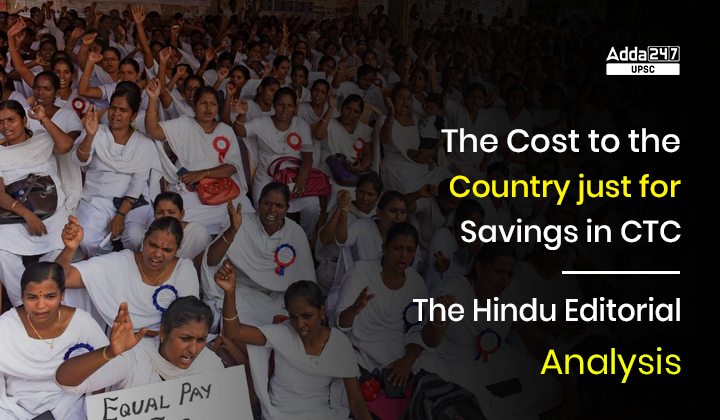Table of Contents
Cost to the Country just for Savings in CTC UPSC Relevance
Status of Employment in India is an important Indicator of Indian Economy and human resource utilization in the Country. Increasing share of contractual workers and decline in the permanent employment is a cause for concern for Indian Economy.
Status of Employment in India is also important for UPSC Prelims 2023 and UPSC Mains Exam (GS Paper 3- Indian Economy and Employment).
Status of Contractual Employment in India
- According to the Periodic Labour Force Survey 2021, India has about 100 million casual workers and 50 million salaried workers with no written job contract.
- This gives us an estimate of 150 million contract workers — or about 30% of the total labour force in the country.
- In the Annual Survey of Industries, the share of contract employment in total industrial employment increased from 24% in 2004 to 38% in 2017.
- These non-payroll contract workers are ubiquitously sighted as technicians, drivers, housekeeping staff in offices and commercial complexes, or just unskilled labour in factories.
- As outsourcing became the trend, many manpower supplier firms mushroomed in the country to meet the ever-growing demand.
- After 2001, the public sector also started outsourcing many vacancies, citing them as non-core activities.
- In the Public Enterprises Survey 2021, the share of casual/contract workers in public sector units (PSUs) was 17.1% in 2011-12, which increased to 19% in 2015-16 and 37.2% in 2020-21.
- There were 4,81,395 contractual workers in central Public Sector Enterprises (CPSEs) in 2021.
- This figure was 2,68,815 in 2011, indicating the conversion of many permanent jobs into contractual ones.
IMFs latest World Economy Report
Benefits to Economy and Companies
- To Economy: Apparently, the cost to the company (CTC) is lower for contract employment when compared to permanent employment.
- This is considered beneficial for the economy as reduced CTC has not only improved profits for India Inc., but also attracts foreign investment.
- To Companies: Besides wages, there are five typical human resource costs: hiring costs, induction costs, career progression costs, severance and superannuation costs.
- Hiring costs are higher for the public sector when compared to the private sector. Millions apply for a few hundred vacancies in the public sector. Conducting examinations on this scale becomes a nightmare for the state machinery.
- Hiring through manpower suppliers is cost and time efficient. As contract labour requires minimal training, it reduces CTC.
- Management prefers contract labour as they are not entitled to the generous paid leave enjoyed by a permanent employee.
- Further saving comes from no commitment to promotion or post-retirement benefits to contractual workers.
- Lastly, the flexibility of firing contractual employees is considered to be positively impacting labour productivity.
Impact of Russia Ukraine War on Indian Economy
Negative Impact of Contractual Employment
- Wage suppression: A major saving in CTC comes from wage suppression. It is a known fact that contractors somehow manage to pay less than minimum wages to labour.
- This means that a majority of the 150 million contractual workers in the country are underpaid.
- The exploitative nature of contract employment has a detrimental distributional effect which keeps the wages of permanent workers suppressed too.
- Dampen Consumption and Saving: Notwithstanding the profits earned by contractors or firms this way, the economy stands to lose on account of reduced consumption and saving.
- Quality Deterioration: Corners cut in hiring and training lead to a deterioration in service quality, which results in second-order losses, and sometimes accidents.
- According to a recent study published in The Lancet, an annual increase in outsourced spending of 1% in the National Health Service in England is associated with a rise in treatable mortality of 0.38%.
- Declining Human Capital: Since underpaid contractual workers cannot afford adequate health care for themselves and their family members, the country’s overall human capital declines.
- As nobody invests in the upskilling of contractual workers, the labour productivity of the economy is also adversely impacted.
- Reduced Export Competitiveness: Low in morale, contractual workers are not as interested in improving the quality of the product and services, thus affecting the export competitiveness of the economy.
Indemnity in Contract Law PCS(J) Study Notes
Innovative Tactics Used by Companies
- Platform and tech companies have devised innovative ways to get around the legal provisions of labour acts.
- For example, designating employees as business partners (in the case of online cab booking and food delivery companies), and segmenting core activity as tech business (in the case of most of the service aggregators).
Way Forward
- While more research is required to quantify the adverse impact of replacing permanent jobs with contract employment, it certainly costs the country’s economy if millions of workers are underpaid and vulnerable to health hazards.
- The well-being of contract workers and their family members should not be the price the country should pay for savings in CTC.
- The argument that permanency of employment breeds inefficiency has its own merit and should be dealt with for its root causes.
- The public sector should reform its appraisal mechanism so as to reward the efficiency of permanent workers.
- The private sector should realise that outsourcing’s cost to the country might be much more than the cost to the company in the long run.
The Editorial Analysis- Create More Jobs, Revamp Employment Policy
The Editorial Analysis- Create More Jobs, Revamp Employment Policy




 TSPSC Group 1 Question Paper 2024, Downl...
TSPSC Group 1 Question Paper 2024, Downl...
 TSPSC Group 1 Answer key 2024 Out, Downl...
TSPSC Group 1 Answer key 2024 Out, Downl...
 UPSC Prelims 2024 Question Paper, Downlo...
UPSC Prelims 2024 Question Paper, Downlo...





